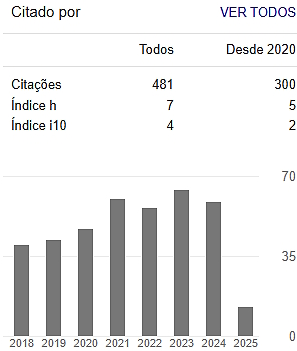STUDY OF THE DYNAMIC BEHAVIOR OF THE HINDMARSH-ROSE NEURONAL MODEL
Keywords:
Hindmarsh-Rose model; Neuronal Dynamics; StabilityAbstract
Based on the Hindmarsh-Rose (RH) neuronal model for nerve impulse transmission, this paper aims to study the properties and dynamic behavior of the non-linear chaotic system that describes neuronal bursting in a single neuron. On the part of bioengineering, there is great motivation in the study of the HR model because it is well representative of the biological neuron, being able to simulate several behaviors of a real neuron, among them periodic, aperiodic and chaotic behavior. The literature suggests that the chaotic behavior represents in the human being the epileptic or convulsive state. Through computer simulations, considering the system parameters, it was analyzed that the stability is highly sensitive to the initial conditions and producing oscillations, more so, when the oscillation increases the random behavior tends to increase making the system unpredictable.
Modelo de Hindmarsh-Rose; Dinâmica Neuronal; Estabilidade.
Downloads
References
da SILVA, F. H. L. et al. Dynamical diseases of brain systems: different routes to epileptic seizures. IEEE transactions on biomedical engineering, v. 50, n.5, p. 540-548, 2003. https://doi.org/10.1109/TBME.2003.810703
FITZHUGH, Richard. Impulses and physiological states in theoretical models of nerve membrane. Biophysical journal, v. 1, n. 6, p. 445-466, 1961. https://doi.org/10.1016/S0006-3495(61)86902-6
HINDMARSCH, J. L.; ROSE, R. A model of neuronal bursting using three coupled first order differential equations. Proc. R. Soc. Lond. B, The Royal Society, v. 221, n. 1222, p. 87–102, 1984. https://doi.org/10.1098/rspb.1984.0024
HODGKIN, A. L.; HUXLEY, A. F. A quantitative description of membrane current and its application to conduction and excitation in nerve. The Journal of physiology, v. 117, n. 4, p. 500–544, 1952. https://doi.org/10.1113/jphysiol.1952.sp004764
JR BUTERA, R. J.; RINZEL, J.; SMITH, J. C. Models of respiratory rhythm generation in thepre-botzinger complex. I. Bursting pacemaker neurons. Journal of neurophysiology, American Physiological Society Bethesda, v. 82, n. 1, p. 382–397, 1999. https://doi.org/10.1152/jn.1999.82.1.382
MILAN, P.; et al. Synchronization and information flow in EEGs of epileptic patients. IEEE Engineering in Medicine and Biology Magazine, v. 20, n.5, p. 65-71, 2001. https://doi.org/10.1109/51.956821
MONTEIRO, L. H. A. Sistemas Dinâmicos. São Paulo, Brasil, Editora Livraria da Física, 2002.
NAGUMO, Jinichi; ARIMOTO, Suguru; YOSHIZAWA, Shuji. An active pulse transmission line simulating nerve axon. Proceedings of the IRE, v. 50, n. 10, p. 2061-2070, 1962. https://doi.org/10.1109/JRPROC.1962.288235
RUGGIERO, M. A. R.; LOPES, V. L. R. Cálculo Numérico. Aspectos teóricos e computacionais. 2 ed., Editora Pearson. 1996.
SAVI, M. A. Dinâmica Não-Linear e Caos, Editora e-papers. 2006.
WOLF, A.; SWIFT, J. B.; SWINNEY, H. L.; VASTANO, J. A. Determining Lyapunov Exponents from a Time Series, Physica, v. 16D, p. 285-317, 1985. https://doi.org/10.1016/0167-2789(85)90011-9

